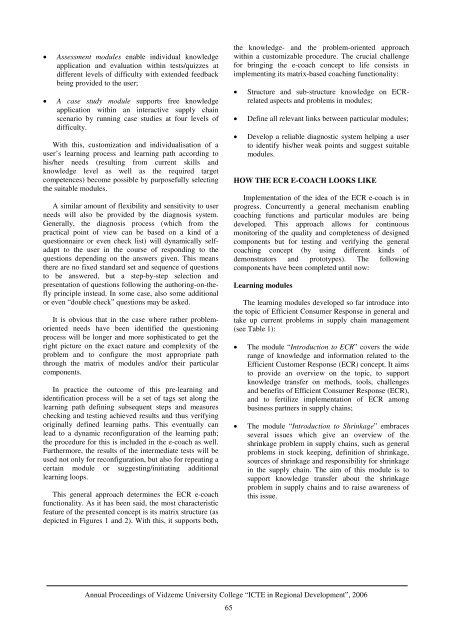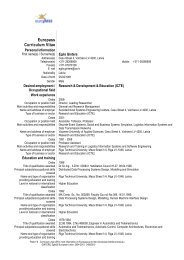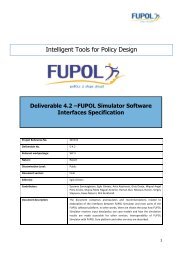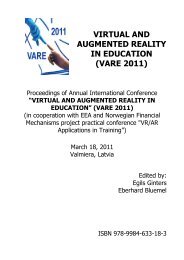Proceedings in pdf format. - Sociotechnical Systems Engineering ...
Proceedings in pdf format. - Sociotechnical Systems Engineering ...
Proceedings in pdf format. - Sociotechnical Systems Engineering ...
Create successful ePaper yourself
Turn your PDF publications into a flip-book with our unique Google optimized e-Paper software.
• Assessment modules enable <strong>in</strong>dividual knowledgeapplication and evaluation with<strong>in</strong> tests/quizzes atdifferent levels of difficulty with extended feedbackbe<strong>in</strong>g provided to the user;• A case study module supports free knowledgeapplication with<strong>in</strong> an <strong>in</strong>teractive supply cha<strong>in</strong>scenario by runn<strong>in</strong>g case studies at four levels ofdifficulty.With this, customization and <strong>in</strong>dividualisation of auser’s learn<strong>in</strong>g process and learn<strong>in</strong>g path accord<strong>in</strong>g tohis/her needs (result<strong>in</strong>g from current skills andknowledge level as well as the required targetcompetences) become possible by purposefully select<strong>in</strong>gthe suitable modules.A similar amount of flexibility and sensitivity to userneeds will also be provided by the diagnosis system.Generally, the diagnosis process (which from thepractical po<strong>in</strong>t of view can be based on a k<strong>in</strong>d of aquestionnaire or even check list) will dynamically selfadaptto the user <strong>in</strong> the course of respond<strong>in</strong>g to thequestions depend<strong>in</strong>g on the answers given. This meansthere are no fixed standard set and sequence of questionsto be answered, but a step-by-step selection andpresentation of questions follow<strong>in</strong>g the author<strong>in</strong>g-on-theflypr<strong>in</strong>ciple <strong>in</strong>stead. In some case, also some additionalor even “double check” questions may be asked.It is obvious that <strong>in</strong> the case where rather problemorientedneeds have been identified the question<strong>in</strong>gprocess will be longer and more sophisticated to get theright picture on the exact nature and complexity of theproblem and to configure the most appropriate paththrough the matrix of modules and/or their particularcomponents.In practice the outcome of this pre-learn<strong>in</strong>g andidentification process will be a set of tags set along thelearn<strong>in</strong>g path def<strong>in</strong><strong>in</strong>g subsequent steps and measurescheck<strong>in</strong>g and test<strong>in</strong>g achieved results and thus verify<strong>in</strong>gorig<strong>in</strong>ally def<strong>in</strong>ed learn<strong>in</strong>g paths. This eventually canlead to a dynamic reconfiguration of the learn<strong>in</strong>g path;the procedure for this is <strong>in</strong>cluded <strong>in</strong> the e-coach as well.Furthermore, the results of the <strong>in</strong>termediate tests will beused not only for reconfiguration, but also for repeat<strong>in</strong>g acerta<strong>in</strong> module or suggest<strong>in</strong>g/<strong>in</strong>itiat<strong>in</strong>g additionallearn<strong>in</strong>g loops.This general approach determ<strong>in</strong>es the ECR e-coachfunctionality. As it has been said, the most characteristicfeature of the presented concept is its matrix structure (asdepicted <strong>in</strong> Figures 1 and 2). With this, it supports both,the knowledge- and the problem-oriented approachwith<strong>in</strong> a customizable procedure. The crucial challengefor br<strong>in</strong>g<strong>in</strong>g the e-coach concept to life consists <strong>in</strong>implement<strong>in</strong>g its matrix-based coach<strong>in</strong>g functionality:• Structure and sub-structure knowledge on ECRrelatedaspects and problems <strong>in</strong> modules;• Def<strong>in</strong>e all relevant l<strong>in</strong>ks between particular modules;• Develop a reliable diagnostic system help<strong>in</strong>g a userto identify his/her weak po<strong>in</strong>ts and suggest suitablemodules.HOW THE ECR E-COACH LOOKS LIKEImplementation of the idea of the ECR e-coach is <strong>in</strong>progress. Concurrently a general mechanism enabl<strong>in</strong>gcoach<strong>in</strong>g functions and particular modules are be<strong>in</strong>gdeveloped. This approach allows for cont<strong>in</strong>uousmonitor<strong>in</strong>g of the quality and completeness of designedcomponents but for test<strong>in</strong>g and verify<strong>in</strong>g the generalcoach<strong>in</strong>g concept (by us<strong>in</strong>g different k<strong>in</strong>ds ofdemonstrators and prototypes). The follow<strong>in</strong>gcomponents have been completed until now:Learn<strong>in</strong>g modulesThe learn<strong>in</strong>g modules developed so far <strong>in</strong>troduce <strong>in</strong>tothe topic of Efficient Consumer Response <strong>in</strong> general andtake up current problems <strong>in</strong> supply cha<strong>in</strong> management(see Table 1):• The module “Introduction to ECR” covers the widerange of knowledge and <strong>in</strong><strong>format</strong>ion related to theEfficient Customer Response (ECR) concept. It aimsto provide an overview on the topic, to supportknowledge transfer on methods, tools, challengesand benefits of Efficient Consumer Response (ECR),and to fertilize implementation of ECR amongbus<strong>in</strong>ess partners <strong>in</strong> supply cha<strong>in</strong>s;• The module “Introduction to Shr<strong>in</strong>kage” embracesseveral issues which give an overview of theshr<strong>in</strong>kage problem <strong>in</strong> supply cha<strong>in</strong>s, such as generalproblems <strong>in</strong> stock keep<strong>in</strong>g, def<strong>in</strong>ition of shr<strong>in</strong>kage,sources of shr<strong>in</strong>kage and responsibility for shr<strong>in</strong>kage<strong>in</strong> the supply cha<strong>in</strong>. The aim of this module is tosupport knowledge transfer about the shr<strong>in</strong>kageproblem <strong>in</strong> supply cha<strong>in</strong>s and to raise awareness ofthis issue.Annual <strong>Proceed<strong>in</strong>gs</strong> of Vidzeme University College “ICTE <strong>in</strong> Regional Development”, 200665









